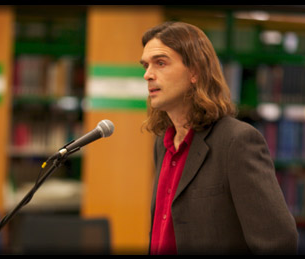Guest Blog: Open Access, a Faculty Viewpoint

Last fall, the Townsend Humanities Lab published a series of posts in this space on issues relating to Open Access and academic e-publishing, and in November of 2010, the Lab hosted a lunch discussion forum on web-based alternatives to the traditional peer review system. Today, we proudly present a guest blog by Sebastiaan Faber (Oberlin Professor and Chair of Hispanic Studies), who provides insight into Oberlin College's decision to commit to Open Access.
In the fall of 2009, the faculty of Oberlin College unanimously adopted an Open Access resolution. This resolution included a double commitment. First, the faculty pledged to consistently report its scholarly publications to the institution. Second, it committed to make the full text of those publications, particularly peer-reviewed articles, openly accessible to the entire world, through a digital institutional repository.
With this resolution, Oberlin joined a growing number of institutions of higher education in committing itself to open access, following the lead of major universities such as Harvard, MIT, and Stanford. Although the principles of open access are straightforward and the Oberlin faculty agreed from the outset that they are indeed laudable, the unanimous faculty vote was the culmination of a year’s worth of debate and deliberation.
Most everyone agreed from the start that making our scholarly work as widely available as possible, and to do so for free, was a good idea—for three main reasons. First, it is good for scholarship to be openly accessible. The current, for-profit system of dissemination does not work well in that respect. It is also bleeding library budgets everywhere. Second, the internet makes open access easier and cheaper than ever. And third, Open Access will make it easier for Oberlin College to showcase to the outside world, but also to itself, its intellectual and scholarly engagement and productivity.
The challenge was to go from principle to practice. How do you translate a laudable goal into the messy and diverse world of scholarly publishing across fields, divisions, and generations? The discussion quickly ran into a host of complicating factors, of which I’ll mention three.
A first issue had to do with the way that faculty conceive of their relationship to their institution. As it turns out, we tend not to see ourselves as employees of a college or university; we are affiliated with it. We do our teaching for the institution, but we hold a much more diverse set of assumptions about the relationship between our institution and the scholarship that we produce. Sure, we tend add our affiliation to our byline; but we don’t see our scholarship as originating in, much less belonging to our college or university.
A second complicating factor was faculty’s relationship to journals, publishers, scholarly associations, and funding sources. Depending on their field, the way in which faculty conceive of their relationship to the other major players in the field of scholarly publication differs widely. Scholars may feel beholden to funders, to publishers, to scholarly associations that publish journals.
A third point of contention was related to career pressures: faculty fear of rocking the boat, missing out, disqualifying themselves. For most faculty, publishing is both absolutely vital and seen as somewhat precarious.
Oberlin’s Library Committee, which took on the challenge of shepherding Open Access to a faculty vote, decided for a gradual, step-by-step approach that would provide ample opportunity for questions, feedback and discussion. This included, crucially, educating our colleagues about their rights as authors and the ease with which they generally give up many of their rights. We further organized workshops with invited speakers, and held separate discussions within the College, Conservatory, and academic divisions and departments. In addition to educating the faculty about the severe problems associated with the current system of scholarly publishing, these sessions served to dispel fears and misinformation. Some faculty were surprised to hear that a large number of journals do in fact allow for some form of author archiving. Others were relieved to hear that a mere inquiry from academic authors about a publisher’s policy on institutional repositories has never yet resulted in a penalization of the author. Of indispensable help in all these discussions was Ray English, Oberlin’s Director of Libraries, who has long been a national advocate for Open Access.
The discussions also served to make up our collective mind on the policy’s actual nature and scope. In the end, Oberlin’s Open Access Policy was largely modeled on Harvard’s. Like Harvard’s, ours is an opt-out policy: all faculty and staff make their scholarship accessible as a matter of course, while anyone can request an exemption at any time, for any publication, for any reason—provided they first report their publication’s metadata. In other words, even if the repository does not end up containing everyone’s work in full-text, it will still reflect the full range of Oberlin’s scholarly productivity. Unlike Harvard’s, moreover, Oberlin’s policy also covers chapters in collected volumes—an important publishing format for many humanists and social scientists.
Since the policy was adopted, library staff have been working on the set-up of the actual repository, modeling it on Harvard’s exemplary DASH (Digital Access to Scholarship at Harvard). Once the repository is in place, it will probably take a while for the faculty to get in the habit of reporting and submitting their publications; to help things along, the administration is devising a way to fold Open Access into the faculty’s regular reporting for purposes of promotion and salary review. The library has also committed to populating the repository with Oberlin scholarship published before the resolution was adopted. The office of Communications, meanwhile, is eagerly awaiting the moment when it can mine the repository for its purposes—showing the world that Oberlin is a vibrant intellectual community of engaging scholar-teachers who are not afraid to share their work with a global public.